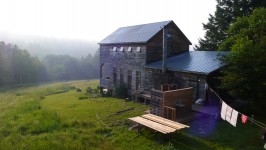…for a few days began this afternoon pulling into the bucolic scene in rural Pennsylvania, just over the Delaware River and the New York state border, where J. Morgan Puett, along with Mark Dion, have managed create an idealist alternative communal living environment/school/artist residency/think-tank/community center. (website)
MILDRED’S LANE is a rustic, 96-acre site deep in the woods of rural northeastern Pennsylvania, in the upper Delaware River Valley, which borders New York state. It is an ongoing collaboration between J. Morgan Puett, Mark Dion, their son Grey Rabbit Puett, and their friends and colleagues. It is a home and an experiment in living. Mildred’s Lane attempts to coevolve a rigorous pedagogical strategy, where a working-living-researching environment has been developed to foster engagement with every aspect of life.
The entire site has become a living museum, or rather – a new contemporary art complex(ity). It is now important to sidestep the debates around what is art ( or design, architecture and fashion) in order to activate these turbulent multiplicities. It is more a question of praxis and action, is it in an institution? Storefront? A gallery? Deep in the woods? At Home?
The Mildred’s Lane site is a home where the Artist/Practitioner, the Student and the Institution have collapsed roles as they attempt to coevolve with an emergent strategy. In conversations with friends and colleagues – who teach and administer theory and practice in a variety of institutions– the frustrations and limitations of conventional, visual art programs and other pedagogies become apparent. However, there is a new excitement to explore alternatives to the way we research-work-live. Mildred’s Lane welcomes this “new age of curiosity” by activating connections that situate themselves at the nexus of science, methods of living, environmental activism, transhistorical and critical artistic practices. This unusual situation affords participants the ability to collaborate in the production of large-scale, socially charged, research- driven projects within a truly transdisciplinary environment. Woven into the project work is a curriculum based on creatively and experimentally living and working together – what we call workstyles. These valuable collaborations are designed to become shared experiences that hope to have transformative and lifelong effects on how artists think of themselves as practitioners functioning in the world.

Recent Comments